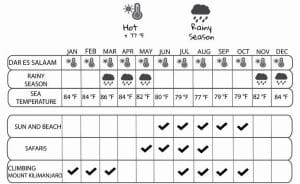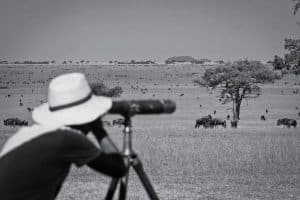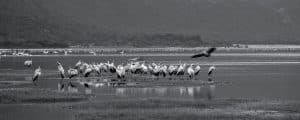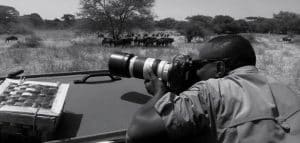Timing it Right: The Ultimate Guide to Choosing the Perfect Time for Your Tanzanian Safari
Step into the wild wonders of Tanzania with a safari that will leave you breathless. But before you embark on this once-in-a-lifetime adventure, you need to answer one question – when is the best time to go to Tanzania for a safari ? This is because, when it comes to safaris, timing is everything! In this ultimate guide, we will reveal the secrets to choosing the best time to go to Tanzania for your safari.
With its diverse landscapes and abundant wildlife, Tanzania offers a safari experience like no other. But different times of the year offer different highlights and challenges. For instance, if witnessing the Great Migration is on your bucket list, then the best time to go Tanzania is from December to July. On the other hand, if birdwatching is your passion, the wet season from November to March will give you the chance to see migratory species in all their glory.
But it’s not just about the wildlife. The time of year also affects the weather and the overall cost of your trip. Don’t get caught in the rain or pay exorbitant prices when knowledge and planning can make a world of difference.
So, whether you want to witness the wildebeest thundering across the plains or enjoy a sun-soaked safari with clear blue skies, the first question to ask is what is the best time to go to Tanzania for a Safari? Once you answer this question, you are ready to make memories that will last a lifetime in Tanzania.
Understanding the different seasons in Tanzania

To choose Tanzania best time to go for a safari, it’s essential to understand the different seasons in the country. Tanzania experiences two primary seasons – the dry season and the wet season. The dry season runs from June to October, while the wet season occurs from November to May.
During the dry season, the weather is generally hot and dry, with clear skies and little to no rainfall. This is considered the peak safari season, as wildlife congregates around water sources, making it easier to spot them. The dry season is also ideal for photography enthusiasts, as the clear skies provide excellent lighting conditions.
On the other hand, the wet season is characterized by rainfall and lush green landscapes. While the rain may make it slightly more challenging to spot wildlife, it is the best time for birdwatching enthusiasts, as migratory species flock to Tanzania. The wet season also offers a unique opportunity to witness the circle of life, as many animals give birth during this time.
The best time for wildlife viewing in Tanzania

If your primary goal is to witness the incredible wildlife that Tanzania has to offer, timing your safari during the dry season is crucial. This is when animals gather around watering holes, making it easier to spot them. The months of June to October are particularly excellent for wildlife viewing, as the vegetation is sparse, and animals are more visible.
Tanzania is home to some of Africa’s most iconic wildlife species, including lions, elephants, giraffes, zebras, and many more. During the dry season, these animals are more active, searching for water and food. The migration of wildebeest and zebras is another highlight of the dry season, as millions of these animals traverse the Serengeti in search of greener pastures.
However, it’s important to note that different parks in Tanzania offer unique wildlife experiences. For example, the Serengeti National Park is famous for its vast herds of wildebeest and zebras, while the Ngorongoro Conservation Area is home to the densest concentration of wildlife in Africa. Researching the specific wildlife you want to see and the parks that offer the best sightings is essential for planning your safari.
Considerations for bird watching enthusiasts
For birdwatching enthusiasts, Tanzania offers a paradise of avian diversity. With over 1,100 recorded bird species, including both resident and migratory species, this East African country is a haven for bird lovers. The wet season, from November to March, is the best time for birdwatching in Tanzania.
During this time, migratory species from Europe and Asia make their way to Tanzania, adding to the already abundant birdlife. The wet season brings with it lush vegetation and an abundance of insects, attracting a wide variety of bird species. From flamingos at Lake Manyara to crowned cranes in the Serengeti, the wet season offers endless opportunities to spot and appreciate the vibrant birdlife of Tanzania.

To make the most of your birdwatching safari, consider hiring a knowledgeable bird guide who can help you identify the different species and their behaviors. Additionally, bring along a good pair of binoculars and a field guide to enhance your birdwatching experience.
Factors to consider for photography enthusiasts
If capturing stunning wildlife and landscape photographs is your goal, timing your Tanzanian safari during the dry season is essential. The months of June to October offer excellent lighting conditions, with clear skies and vibrant colors. The sparse vegetation during this time allows for unobstructed views of animals and landscapes.
To capture the best wildlife photographs, consider visiting the Serengeti during the dry season when the Great Migration is in full swing. The sight of thousands of wildebeest and zebras traversing the plains is an awe-inspiring spectacle that should not be missed. Additionally, the Ngorongoro Crater provides a unique opportunity to capture close-up shots of wildlife against the backdrop of the crater walls.

While the dry season is ideal for photography, don’t discount the wet season entirely. The lush green landscapes and dramatic cloud formations during this time can add a unique element to your photographs. Just be prepared for the occasional rain shower and ensure you have waterproof protection for your camera equipment.
Weather conditions and their impact on safaris
The weather conditions in Tanzania can significantly affect your safari experience. Understanding the climate patterns and their impact on wildlife behavior is crucial for choosing the perfect time for your Tanzanian safari.
During the dry season, the weather is generally hot and dry, with temperatures ranging from 70°F to 90°F (21°C to 32°C). This is the best time for wildlife viewing, as animals congregate around water sources. Mornings and evenings are cooler, making game drives more comfortable. However, it’s important to pack lightweight, breathable clothing and sunscreen to protect yourself from the sun.
In contrast, the wet season brings rainfall and cooler temperatures. Daytime temperatures range from 65°F to 80°F (18°C to 27°C), with occasional afternoon showers. The wet season is considered the low season for safaris, meaning fewer crowds and lower prices. However, the rain may make some roads impassable, and wildlife may be more dispersed, making sightings more challenging.
Timing considerations for wildebeest migration
The Great Migration is one of the most remarkable wildlife spectacles on earth, and witnessing it should be on every safari-goer’s bucket list. Over two million wildebeest, zebras, and gazelles move across the Serengeti and Maasai Mara ecosystems in search of fresh grazing.
To time your safari perfectly for the Great Migration, you need to consider the wildebeest’s movement patterns. The migration is a continuous cycle, with specific events happening at different times of the year. In December, the herds gather in the southern Serengeti for the calving season. This is a prime time to witness the incredible sight of newborn wildebeest taking their first steps.
From January to March, the herds start moving northwest in search of greener pastures. By April, they reach the western corridor of the Serengeti, where they face the daunting task of crossing the Grumeti River. This river crossing is a thrilling event, as crocodiles lie in wait for their prey.
From June to July, the herds start their northern journey, crossing the Mara River into the Maasai Mara in Kenya. This is the most dramatic river crossing, with predators lurking at every turn. By October, the herds start making their way back south into the Serengeti, completing the cycle.
To witness the Great Migration, plan your safari around these key events. However, keep in mind that the exact timing of the migration can vary from year to year based on rainfall patterns and other factors. Working with a knowledgeable safari operator can help ensure you are in the right place at the right time to witness this awe-inspiring natural phenomenon.
Off-peak and peak seasons for budget travelers
If you’re traveling on a budget, timing your Tanzanian safari during the off-peak seasons can save you money without compromising on the safari experience. The off-peak seasons typically coincide with the wet season, which runs from November to March.
During the wet season, prices for accommodations and safari packages are generally lower, and there are fewer tourists. This means you can enjoy a more intimate safari experience while saving money. Additionally, some lodges and camps offer special discounts and promotions during this time to attract visitors.
However, it’s important to consider the potential challenges of traveling during the wet season. The rain may make some roads impassable, and wildlife may be more dispersed, making sightings more challenging. It’s advisable to choose lodges or camps with good all-weather access roads and experienced guides who can navigate the changing conditions.
On the other hand, the peak season for safaris in Tanzania is during the dry season, from June to October. Prices during this time are generally higher, and popular parks and accommodations may be fully booked well in advance. If you choose to travel during the peak season, make sure to plan and book your safari well ahead of time to secure the best accommodations and experiences.
Tips for choosing the perfect time for your Tanzanian safari
Choosing the perfect time for your Tanzanian safari depends on your specific interests and priorities. Here are some tips to help you make the best decision:
- Identify your priorities: Is witnessing the Great Migration your main goal? Or are you more interested in birdwatching or photography? Understanding your priorities will help you determine the best time to visit.
- Research wildlife behavior: Different animals have different activity patterns throughout the year. Research the wildlife species you want to see and their behavior during different seasons to plan your safari accordingly.
- Consider the weather: Tanzania’s weather patterns can significantly impact your safari experience. If you prefer dry and sunny conditions, the dry season is ideal. If you don’t mind occasional rain showers and lush green landscapes, the wet season can offer unique opportunities.
- Plan in advance: Whether you choose to travel during the peak or off-peak season, it’s important to plan and book your safari well ahead of time. This will ensure you secure the best accommodations, guides, and experiences.
- Work with a reputable safari operator: To make the most of your Tanzanian safari, consider working with a reputable safari operator who has expert knowledge of the country and its wildlife. They can help you plan your itinerary and ensure you are in the right place at the right time to maximize your safari experience.
Making the most of your safari by timing it right
Choosing the perfect time for your Tanzanian safari can make all the difference in your overall experience. Whether you want to witness the Great Migration, indulge in birdwatching, or capture stunning photographs, understanding the seasons, wildlife behavior, and weather conditions is crucial.
The dry season offers excellent wildlife viewing opportunities, with animals congregating around water sources. It’s also the best time for photography enthusiasts, thanks to the clear skies and vibrant colors. On the other hand, the wet season is ideal for birdwatching, with migratory species flocking to Tanzania.
Consider your priorities, research wildlife behavior, and plan in advance to choose the perfect time for your Tanzanian safari. And remember, working with a reputable safari operator can help ensure you have a memorable and well-timed safari experience in Tanzania. So, get ready to time it right and embark on an adventure that will leave you in awe of the incredible wildlife and landscapes of Tanzania.
For more articles related to Things to Do in Tanzania (Zanzibar), click here!


































